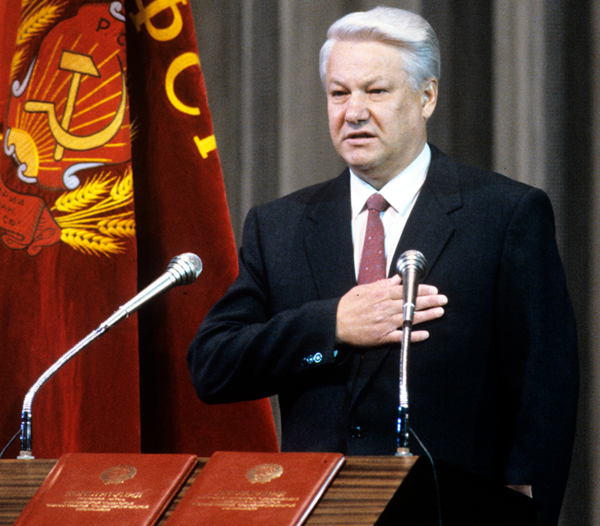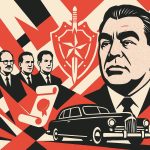
Russia is still ruled by the nomenklatura
In today’s Russia, there is very little awareness that the nomenklatura created by Joseph Stalin, which came to power in 1937-1938, still governs the country. In the early 1990s, there was no real change of power; there was only a change in the economic course carried out by the same organization that Stalin had established. We have already shown in this article exactly how the General Secretary carried out a state coup, resulting in the destruction of the Bolshevik party and the seizure of power and enterprises by the conservative nomenklatura. As noted, of the 1,966 delegates to the 17th Party Congress in 1934, 1,108 were repressed. When after 1938 was there such a radical change in Russia’s ruling class?
The overwhelming majority of senior state officials in the 1990s were party nomenklatura, which had evolved since the Stalinist coup. Boris Yeltsin was a candidate for membership in the Politburo of the CPSU Central Committee. Yegor Gaidar headed the Department of Economic Policy at the CPSU Central Committee journal «Kommunist». Viktor Chernomyrdin was Minister of the Gas Industry of the USSR. Yuri Luzhkov was head of the Department of Science and Technology at the Ministry of Chemical Industry of the USSR. Nikolai Ryzhkov was a Politburo member of the CPSU Central Committee and Chairman of the Council of Ministers. Gennady Seleznyov was editor-in-chief of «Komsomolskaya Pravda» and a member of the CPSU Central Committee. Alexander Yakovlev was a secretary of the CPSU Central Committee. And so on.

The nomenklatura continued to rule not only at the top levels but also in the provinces, starting with Saint Petersburg, whose former governor Valentina Matviyenko was Deputy Chair of the Executive Committee of the Leningrad City Council of People’s Deputies during the Soviet period. The “eternal” governor of Belgorod Oblast, Yevgeny Savchenko, was the first secretary of the Shebekino City Committee of the CPSU in Belgorod Oblast. The head of the Republic of Mordovia, Vladimir Volkov, was first secretary of the Saransk City Committee of the Komsomol. The governor of Kaluga Oblast, Anatoly Artamonov, was first secretary of the Mosalsky District Committee of the CPSU. And so on.
Looking at the composition of the USSR Council of Ministers in 1989-1991:
- Nikolai Ivanovich Ryzhkov — Chairman of the USSR Council of Ministers (member of the Federation Council of the Federal Assembly of the Russian Federation since 2003);
- Yuri Dmitrievich Maslyukov — First Deputy Chairman of the USSR Council of Ministers (First Deputy Prime Minister of Russia in 1998–1999);
- Vladimir Kuzmich Gusev — Deputy Chairman of the USSR Council of Ministers (member of the Federation Council 2001–2012);
- Vitaly Khusseynovich Doguzhiev — Deputy Chairman of the USSR Council of Ministers (1992–1996, President of the Military-Industrial Investment Company);
- Lev Dmitrievich Ryabev — Deputy Chairman of the USSR Council of Ministers (First Deputy Minister of the Russian Federation for Atomic Energy 1993–2002);
- Ivan Stepanovich Silaev — Deputy Chairman of the USSR Council of Ministers (joined the board of directors of Yukos in 2005);
- Vitaly Fedorovich Konovalov — Minister of Atomic Energy and Industry of the USSR (First Deputy Minister of the Russian Federation for Atomic Energy 1992–1996);
- Nikolai Andreevich Pugin — Minister of Automotive and Agricultural Machinery of the USSR (elected President of OAO GAZ in 1994);
- Konstantin Fedorovich Katushev — Minister of Foreign Economic Relations of the USSR (held senior positions in several commercial banks in the post-Soviet period, including Diamant and VIP Bank).
We could continue, but there is no need. For the most part, they either remained in power or appropriated some business for themselves.
Even the buildings remained the same decades later. The Government House of the Russian Federation in 1984–1992 was called the “House of Soviets of the RSFSR”. The State Duma building previously housed the Council of Ministers and Gosplan. The Presidential Administration building was the CPSU Central Committee, and the state security organs remained in their formidable building on Lubyanka Square.
Professor of Political Science at the Higher School of Economics, Yuliy Nisnevich, in his 2007 work «Audit of the Political System of Post-Communist Russia», writes: “Today, among the state-bureaucratic component of the Russian nomenklatura, 77% come from the Soviet nomenklatura, while 41% of its economic component do. Among the remaining 59% of non-nomenklatura entrepreneurs, a significant proportion are from nomenklatura families1“. These same data are cited in Olga Kryshtanovskaya’s work «Anatomy of the Russian Elite»2. Additionally, Kryshtanovskaya writes:
It is precisely in our time that the talk of the revival of the nomenklatura has resurfaced. It survived the horrors of the 1990s reforms, adapted, changed its image — but remained in power… After many blows, the nomenklatura recovered: the “table of ranks” was restored, the “noble nests” of elite neighborhoods were rebuilt better than before, and special ateliers with dedicated transport remained in place. They talked, talked about democratization, and well… it will come… The old lady nomenklatura is alive, alive! So read Voslensky — you will find many instructive analogies!3
This dense presence of the nomenklatura in the upper echelons of power is confirmed by the “architect” of privatization, Anatoly Chubais:
Our “new Russians” are either from the old Soviet directorate, with all its pros and cons, or from former cooperatives and various other businesspeople from the Perestroika period, or from representatives of the former regional political elites. Each of them has their own “birthmarks”, but it is precisely from these people that the real strategic owners are recruited4.
The draft law submitted to the State Duma on December 17, 1992, also noted:
High-ranking Communist nomenklatura, including those involved in the anti-constitutional coup, suffered virtually no moral or material losses anywhere in the regions; many of its members remain in positions of power5.
Thus, despite the seemingly significant political upheavals of the early 1990s, the nimble portion of the nomenklatura quickly adapted and managed to remain in power. According to Nisnevich, this occurred as follows:
Representatives of the progressive part of the Soviet nomenklatura, who came to power alongside representatives of the democratic movement, recreated in the presidential and government structures formed after B. Yeltsin’s election as President of the Russian Federation in June 1991, the nomenklatura methods and mechanisms of behind-the-scenes decision-making, interpersonal, and group interactions inherently characteristic of them.
<…>
…the middle and lower levels of the Russian state apparatus were almost immediately staffed almost entirely with officials who had previously worked in the party-state apparatus of the USSR and RSFSR. The core of professionalism of such officials consisted primarily of their mastery of bureaucratic record-keeping, behind-the-scenes decision-making, and techniques of office intrigue6.
Interestingly, Leon Trotsky had already anticipated such a development in the 1930s:
Privileges are worth only half their price if they cannot be inherited by one’s children. But the right of bequest is inseparable from the right of property. It is not enough to be a director of a trust; one must be a shareholder. A victory of bureaucracy in this crucial area would mean its transformation into a new property-owning class7.
Moreover, the nomenklatura not only remained in power and privatized enterprises — gaining the ability to send their children abroad to spend public funds — but also largely retained their privileges from the USSR era, now with a guaranteed ability to pass them on to their offspring. Once we acknowledge the fact stated in the headline, it becomes clear why in the Russian Federation there is an effort to popularize Joseph Stalin and obscure the political content of the 1937–1938 repressions — fully exposing the General Secretary’s crimes would reveal that the current government is even more illegitimate than one might have thought.
- Y.A. Nisnevich. Audit of the Political System of Post-Communist Russia. – 302 pages. – Moscow: Materik, 2007. – p. 255.
- O. Kryshtanovskaya – «Anatomy of the Russian Elite»
- M. Voslensky. «Nomenklatura». — Moscow: Zakharov, 2005. — 640 pages.
- A. Chubais – «Privatization the Russian Way»
- G. Starovoitova. Project “On the Ban on Professions for the Leaders of a Totalitarian Regime”. December 17, 1992.
- Y.A. Nisnevich. «Audit of the Political System of Post-Communist Russia». – 302 pages. – Moscow: Materik, 2007. – pp. 246-247.
- Leon Trotsky – «The Betrayed Revolution»


